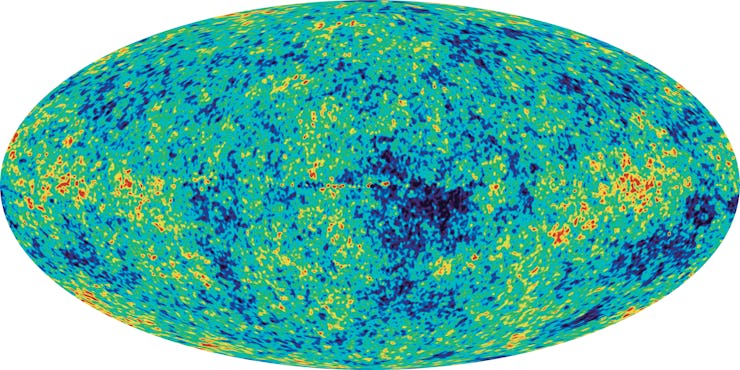New Measurements of the Big Bang's Afterglow Prove Einstein Right Again
The Atacama Cosmology Telescope confirmed his theory of gravity again.

This week, an international team of more than 160 astronomers working with the Atacama Cosmology Telescope released three preprint papers submitted to The Astrophysical Journal unveiling the most comprehensive and precise map of mass in the Universe — and, to their surprise, it looked exactly as they expected. The three papers describe the map’s parameters, the pipeline used to build the map, and how they dealt with sources of interference more recent than the earliest days of the universe.
“When I first saw them, our measurements were in such good agreement with the underlying theory that it took me a moment to process the results,” Frank Qu, a doctoral candidate at Cambridge and a lead author on one of the papers, said in a statement.
That’s because the Atacama Cosmology Telescope, or ACT, uses the energy of the cosmic microwave background — the energy of the early Universe before it cooled off enough for atoms to form — in order to map out dark matter, the 85 percent of the Universe’s matter (and 27 percent of its mass) that doesn’t interact with electromagnetic radiation at all.
But the ACT’s survey of dark matter doesn’t just show the extent of dark matter across the universe. The cosmic microwave background is “lumpy”: Some parts are denser and hotter than others. By comparing their precise map of the CMB to a map of visible galaxies, they can map the existing universe to its earliest days, which also confirms that it’s scattered across it in a way that fits right into the standard model of cosmology derived from Einstein’s theory of gravity.
The Atacama Cosmology Telescope, nestled in the desert of Chile.
Hunting for the Afterglow
The ACT, which began operation in 2007 and shut down last year, has acted as a follow-up to two famous space telescopes, NASA’s Wilkinson Microwave Anisotropy Probe (WMAP) and the ESA’s Planck telescope, which mapped the cosmic microwave background from 2001 to 2010 and 2009 to 2013, respectively.
ACT, nestled high in Chile’s Atacama Desert, offers one big advantage over space-based telescopes: it’s, well, big. “The concept of a big mirror for people is ‘bigger is more sensitive,’” Mark Devlin, an astronomer at the University of Pennsylvania and deputy director of the ACT, tells Inverse. “And that’s sort of true — but for us in radio, bigger also means higher-resolution, it means you can detect finer detail in the angular distribution of things on the sky.”
How much bigger? Mark Halpern, an astronomer at the University of British Columbia, explains in an interview with Inverse: “Planck, for example, was a nice instrument — 53 detectors. One of the things ACT has going for it is it has a hundred times more detectors and a huge level of uniformity and sensitivity.” This included being able to be regularly upgraded.
This means that ACT was able to map out the sky with a tremendous level of sensitivity. Mat Madhavacheril, also an astronomer at the University of Pennsylvania, tells Inverse “maps that were over larger scales that were made by experiments like Planck, if you looked at that map half of it is signal, half of it is noise.” While astronomers were able to do research with Planck’s maps because they were looking at very large scales, Madhavacheril says that the question remained: “So are you really seeing structures?”
The Planck mission helped astronomers understand more about cosmic dawn.
Gravitating Toward an Answer
Since Planck’s mapping efforts a decade ago, some astronomers have grown increasingly unsure if models based on the CMB, rather than on light from galaxies or supernovae, were accurately representing the structure of the universe. It seemed that the distribution of matter across cosmological scales wasn’t lumpy enough under Einstein’s theory of gravity. But with these higher-resolution maps of matter, Halpern says, “The cosmological part of this model is completely healthy.”
“We have an actual mass map,” Devlin says. Where surveys of the cosmic microwave background like Planck once saw a wide statistical approximation, “you can really point to this spot and say there’s something there.”
ACT had a resolution of 1 arc-minute, or about 1/30th the diameter of the moon in the night sky. While this is far from the smallest scale astronomers observe at, the precision allows astronomers to match the growth of cosmic structures like groups of galaxies and the dark matter surrounding them with their antecedents in the cosmic dawn.
Devlin likens it to looking only at the cosmic microwave background—light that’s nearly 14 billion years old—and predicting what the universe looks like today. “And you go and predict it and say ok, then you go and measure it, and you see exactly what you predicted—that’s what’s happening here.”
The ACT map isn’t just important because of its precision, though. The map matches well with other measurements that it doesn’t rely on, and these independent measurements confirm both Einstein’s theory of gravity and the familiar standard model of cosmology. If that’s the case, Madhavacheril says, that means this map’s precision might be a way of measuring the growth of the cosmic structure to understand what’s really behind those discrepancies. “What’s really exciting is there’s a path forward to possibly pinning down what this physics is,” he adds.
This article was originally published on